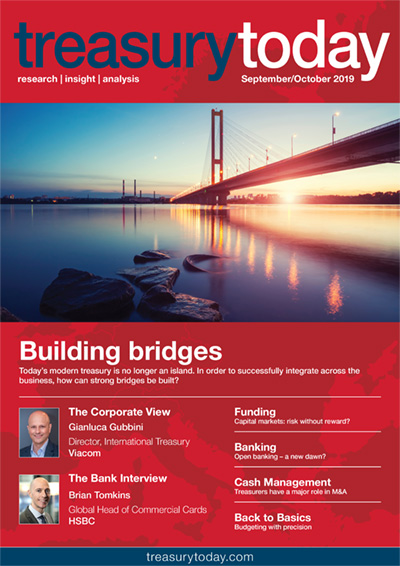Contents
- Editorial
- The rise and rise of the connected treasurer
- Insight & Analysis
- Building bridges
- Funding
- Capital markets: the rules of engagement for volatile times
- Sector Trends: Citi
- Are you receiving me? Exploring the ‘dark side’ of the balance sheet
- The Corporate View
- Corporate View: Gianluca Gubbini, Viacom International Media Networks
- Banking
- For banks, the future is a foreign country – but they still speak the same language
- Ultra-short strategy: J.P. Morgan Asset Management
- Hitting the ultra-short sweet spot: managing cash through macro uncertainty
- Cash Management
- Bringing the deal home: treasury’s vital role in M&A; success
- Digitisation: Standard Chartered
- Keeping it real: making new technologies and market forces work for you
- Back to Basics
- Zero-based budgeting: a precise model for an unpredictable world
- The Bank Interview
- Bank Interview: Brian Tomkins, HSBC
- Question Answered
- Question Answered: End of bank monopoly?
- Market View
- Monetary policy is losing its effectiveness and there’s a risk of a dollar squeeze
- Advertorial
- The rise of the well-connected treasurer
Editorial
The rise and rise of the connected treasurer
Treasury once resided in an ivory tower within its own organisation; an inscrutable technical wizard that somehow made sure the bills were paid. Often the only time people knew it was there was when something went wrong.
That has all changed. Today, treasury has become – in the eyes of the rest of the business – the function that keeps the business afloat in a raging financial sea. This makes it very much a part of the gang.
As a vital part of this service, treasuries are becoming much more integrated with core teams such as procurement and sales, using data and knowledge to build an accurate reflection of the company’s financial needs. In making that connection, treasurers are also able to assist diverse functions in building relationships with suppliers, and even helping clients in their own financing needs.
Who’d have thought this was likely a decade or so ago? Few, probably. But treasurers have been busy communicating effectively across the organisation and beyond, forming real partnerships, and often harnessing cutting edge technologies to build closer connections.
You only have to look at the winners of this year’s Adam Smith Awards to see just how inventive individual treasuries are when it comes to building rapport and making digital connections within and without the business. For example, Treasury Today’s Top Treasury Team 2019 overall winner, Honeywell, has been exploiting cloud technology keep its stakeholders up to speed across its vast global enterprise.
Accordingly, the notion of the connected treasurer is one that has gained much credence in recent times. Last year’s ACT report, The Business of Treasury, found that 87% of respondents saw treasury as a strategic business partner in their organisations. PwC followed up with its 2019 Global Treasury Benchmarking Survey, identifying business partnering capabilities as one of the top three characteristics “most sought after in treasurers and their teams, beyond functional treasury expertise”.
In our Insight & Analysis piece in this edition we explore the extent to which collaboration between treasury and the rest of the business helps the entire company to be (as one interviewee put it) “safer, more streamlined, and more efficient”.
Of course, there’s much to be gained by building closer connections between treasury and the rest of the business – and there are many ways in which the function can demonstrate its indispensable nature. Indeed, elsewhere in this edition we look at the role of the treasurer in M&A, the future of bank relationships and treasury’s movements in the capital markets. And for our Back to Basics article we probe the idea of zero-based budgeting, an activity that requires close cooperation and strong connections if ever there was one!


